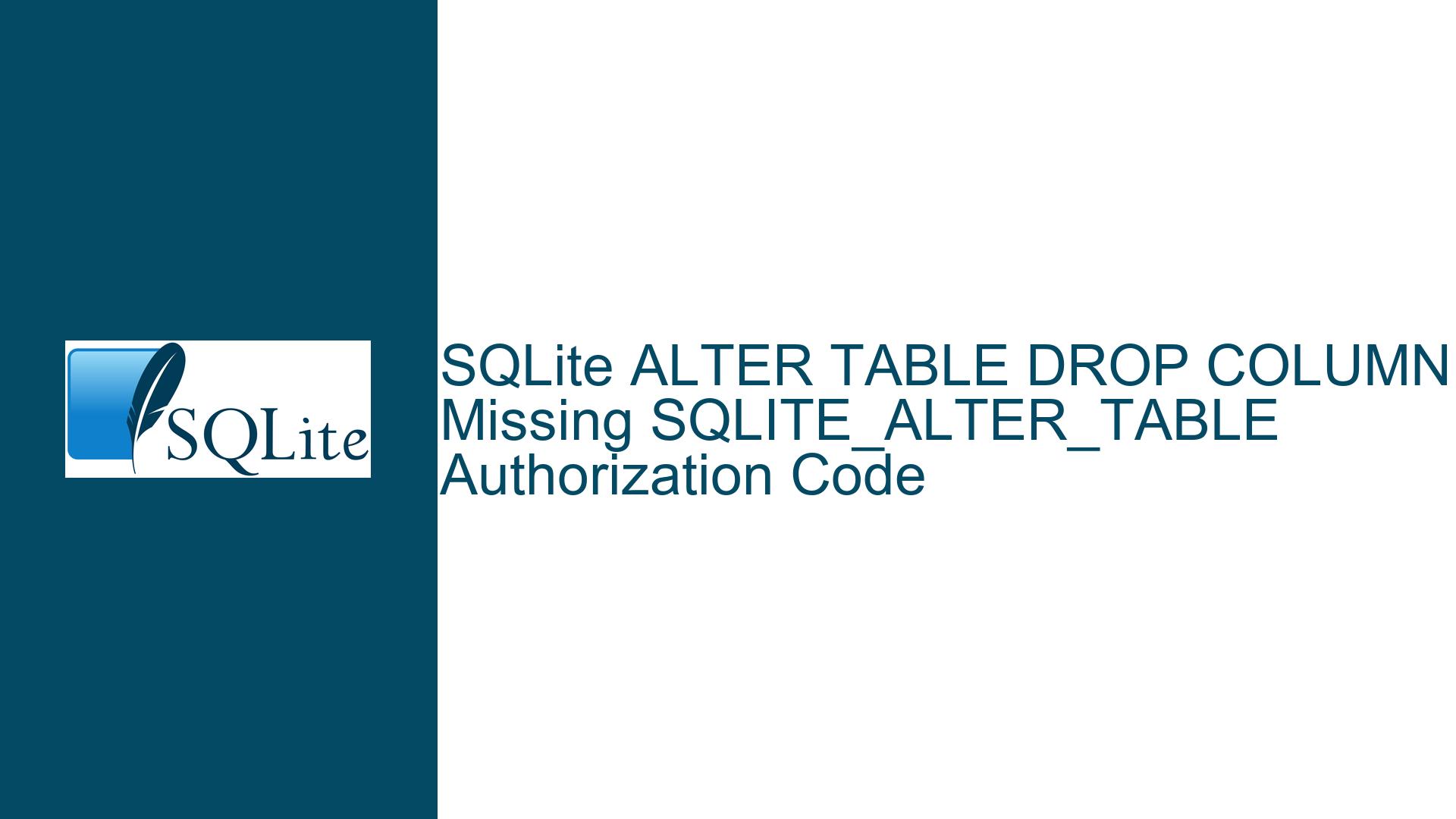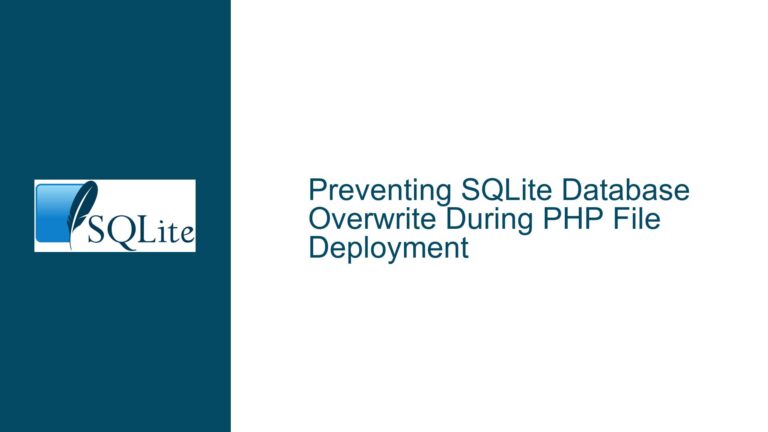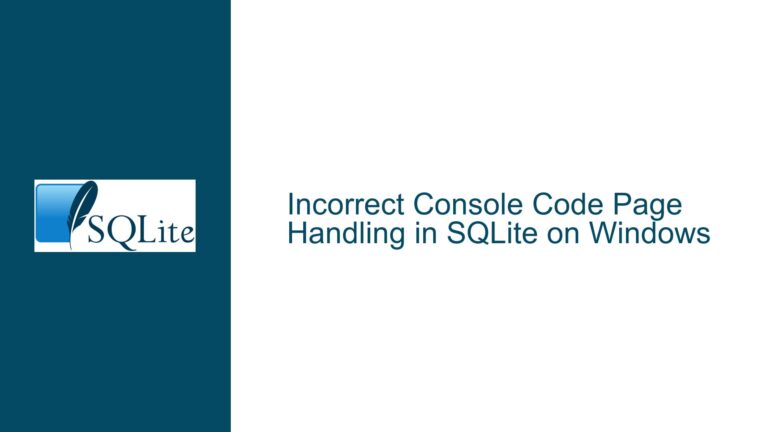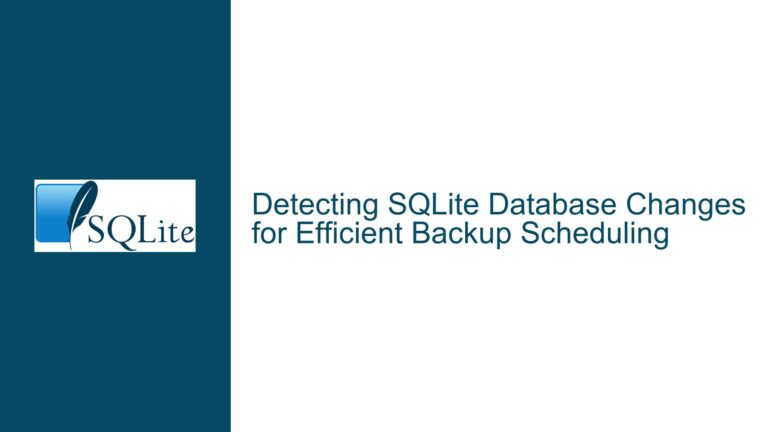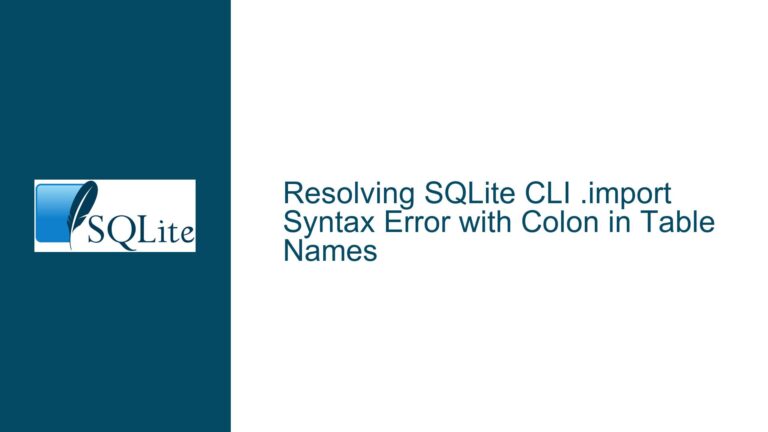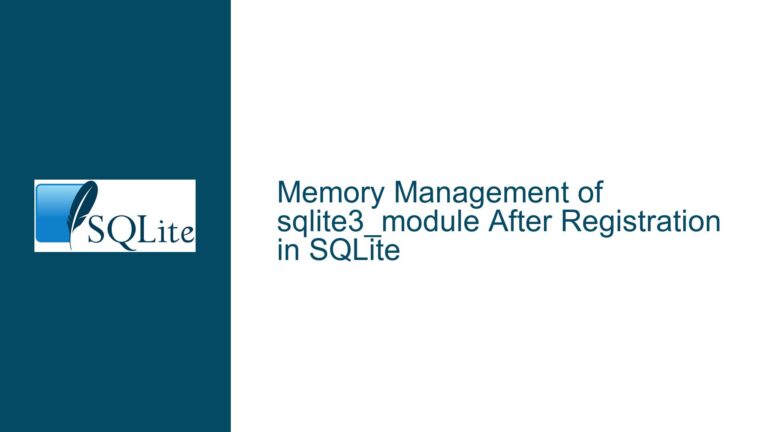SQLite ALTER TABLE DROP COLUMN Missing SQLITE_ALTER_TABLE Authorization Code
Issue Overview: SQLITE_ALTER_TABLE Authorization Code Not Triggered by ALTER TABLE DROP COLUMN
The core issue revolves around the behavior of SQLite’s authorization callback mechanism when executing the ALTER TABLE DROP COLUMN statement. Specifically, the SQLITE_ALTER_TABLE authorization code, which is expected to be reported to the authorization callback during table alteration operations, is not triggered when a column is dropped from a table. This behavior is inconsistent with other table alteration statements, such as ALTER TABLE RENAME or ALTER TABLE ADD COLUMN, which correctly report the SQLITE_ALTER_TABLE code.
The authorization callback in SQLite is a powerful feature that allows developers to monitor or restrict database operations based on specific authorization codes. These codes are designed to provide granular control over database activities, ensuring that only authorized operations are performed. The absence of the SQLITE_ALTER_TABLE code during a DROP COLUMN operation can lead to security vulnerabilities or misbehavior in applications that rely on the authorization callback for auditing or access control.
The issue was first observed in SQLite version 3.35.0, where the ALTER TABLE DROP COLUMN feature was introduced, and persists up to version 3.37.2. During the execution of a DROP COLUMN statement, the authorization callback receives several other codes, such as SQLITE_FUNCTION, SQLITE_READ, and SQLITE_UPDATE, but notably omits SQLITE_ALTER_TABLE. This omission can be problematic for applications that depend on the authorization callback to track or restrict table alteration operations.
Possible Causes: Why SQLITE_ALTER_TABLE is Missing in DROP COLUMN Operations
The absence of the SQLITE_ALTER_TABLE authorization code during ALTER TABLE DROP COLUMN operations can be attributed to several potential causes, rooted in the implementation details of SQLite’s authorization mechanism and the DROP COLUMN feature.
Implementation Oversight in the DROP COLUMN Feature: The
ALTER TABLE DROP COLUMNfeature was introduced in SQLite 3.35.0, and it is possible that the integration of this feature with the authorization callback mechanism was incomplete. Specifically, the code path responsible for triggering theSQLITE_ALTER_TABLEauthorization code may have been inadvertently omitted during the implementation of theDROP COLUMNfunctionality.Authorization Code Handling in Internal Functions: SQLite’s
DROP COLUMNoperation involves a series of internal steps, including renaming the original table, creating a new table without the dropped column, copying data from the old table to the new table, and updating the schema. Each of these steps may trigger different authorization codes. It is possible that theSQLITE_ALTER_TABLEcode is not explicitly associated with the high-levelDROP COLUMNoperation but is instead tied to specific internal functions that are not invoked in this context.Inconsistent Authorization Logic Across Table Alteration Operations: SQLite supports multiple table alteration operations, such as
ADD COLUMN,RENAME COLUMN, andDROP COLUMN. Each of these operations may have distinct authorization logic, leading to inconsistencies in how authorization codes are reported. TheDROP COLUMNoperation may have been treated as a special case, resulting in the omission of theSQLITE_ALTER_TABLEcode.Behavioral Differences in Temporary and Main Databases: The authorization callback logs provided in the discussion reveal that the
DROP COLUMNoperation interacts with both the main database and the temporary database (sqlite_temp_master). It is possible that the authorization logic for temporary databases differs from that of main databases, leading to the omission of theSQLITE_ALTER_TABLEcode.Interaction with the
sqlite_drop_columnFunction: The authorization callback logs indicate the presence of aSQLITE_FUNCTIONcode associated with thesqlite_drop_columnfunction. This suggests that theDROP COLUMNoperation may be implemented as a function call rather than a direct table alteration operation, which could explain why theSQLITE_ALTER_TABLEcode is not triggered.
Troubleshooting Steps, Solutions & Fixes: Addressing the Missing SQLITE_ALTER_TABLE Code
To address the issue of the missing SQLITE_ALTER_TABLE authorization code during ALTER TABLE DROP COLUMN operations, several troubleshooting steps and solutions can be considered. These include workarounds for existing SQLite versions, as well as long-term fixes for future releases.
Workaround: Rely on the
sqlite_drop_columnFunction Authorization Code: As observed in the authorization callback logs, theDROP COLUMNoperation triggers aSQLITE_FUNCTIONcode associated with thesqlite_drop_columnfunction. This code can be used as a proxy for detectingDROP COLUMNoperations in applications that rely on the authorization callback for observation or auditing purposes. However, this workaround is not ideal for security-critical applications, as it does not provide the same level of granularity as theSQLITE_ALTER_TABLEcode.Patch Application for Immediate Fix: The issue has been resolved in the SQLite trunk (development version), and a patch is available for application. Developers can apply the patch to their local SQLite builds to ensure that the
SQLITE_ALTER_TABLEcode is correctly reported duringDROP COLUMNoperations. The patch can be obtained from the SQLite source repository and applied using standard patching tools.Upgrade to Future SQLite Releases: The SQLite development team has confirmed that the issue will be fixed in future releases. Developers are advised to upgrade to the latest stable version of SQLite once the fix is included. This is the most straightforward and recommended solution for ensuring consistent behavior across all table alteration operations.
Custom Authorization Callback Logic: For applications that require immediate resolution and cannot wait for a future SQLite release, custom logic can be implemented in the authorization callback to infer
DROP COLUMNoperations based on the presence of thesqlite_drop_columnfunction code. This approach involves analyzing the sequence of authorization codes and identifying patterns that correspond toDROP COLUMNoperations.Testing and Validation: After applying a patch or upgrading to a fixed version of SQLite, thorough testing is essential to validate that the
SQLITE_ALTER_TABLEcode is correctly reported duringDROP COLUMNoperations. This includes testing with various table schemas, column types, and database configurations to ensure consistent behavior.Monitoring SQLite Development: Developers should monitor the SQLite development timeline and release notes to stay informed about bug fixes and new features. This proactive approach ensures that issues are addressed promptly and that applications remain compatible with the latest SQLite versions.
Community Engagement and Bug Reporting: The SQLite community plays a crucial role in identifying and resolving issues. Developers are encouraged to report bugs and contribute to discussions on the SQLite forum or GitHub repository. Clear and detailed bug reports, including reproducible test cases and authorization callback logs, facilitate faster resolution by the SQLite development team.
Security Considerations: For applications that rely on the authorization callback for security purposes, the absence of the
SQLITE_ALTER_TABLEcode duringDROP COLUMNoperations poses a significant risk. Developers should implement additional security measures, such as schema validation and access control checks, to mitigate potential vulnerabilities until the issue is resolved.Documentation Updates: The SQLite documentation should be updated to reflect the behavior of the authorization callback during
DROP COLUMNoperations. This includes clarifying the conditions under which theSQLITE_ALTER_TABLEcode is reported and providing guidance on workarounds for affected applications.Long-Term Architectural Review: The SQLite development team should conduct a comprehensive review of the authorization callback mechanism to ensure consistent behavior across all table alteration operations. This includes evaluating the integration of new features with the authorization system and addressing any discrepancies in authorization code reporting.
By following these troubleshooting steps and solutions, developers can address the issue of the missing SQLITE_ALTER_TABLE authorization code during ALTER TABLE DROP COLUMN operations. The combination of immediate workarounds, patch application, and long-term fixes ensures that applications remain secure, reliable, and consistent with SQLite’s authorization callback mechanism.
